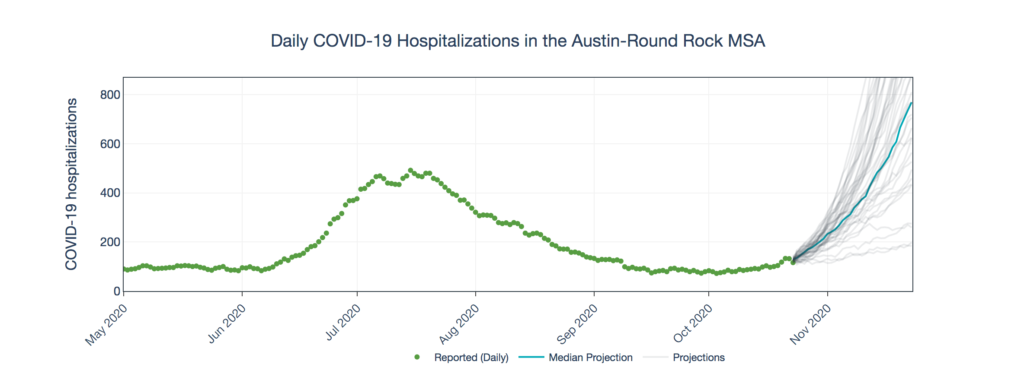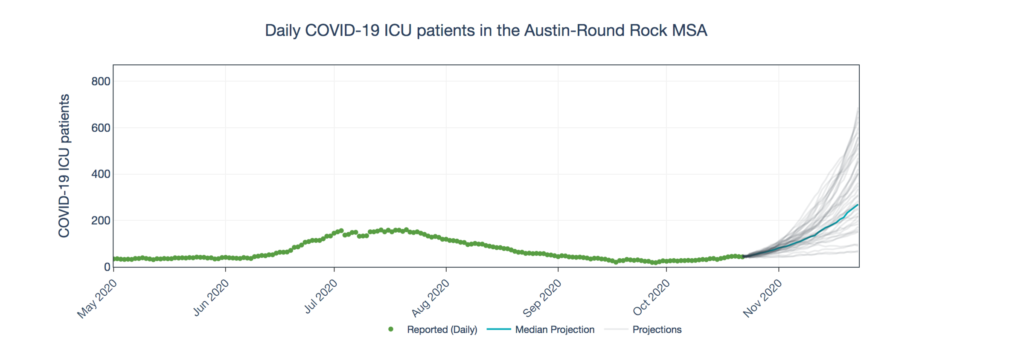Photo by Gabriel C. Pérez/KUT News
Austin’s top doctor warns November Covid surge could be worse and last longer than the first
Wednesday, October 28, 2020 by
Jerry Quijano, KUT There is a 100 percent probability that the coronavirus epidemic is growing in the Austin metro area, according to modeling from the University of Texas Modeling Consortium.
As other areas across Texas – most notably El Paso – experience new surges of Covid-19 cases and hospitalizations, the city’s interim health authority says Austinites must remain vigilant.
“They are in a crisis right now, and this is certainly something that we have to pay attention to,” Dr. Mark Escott told Travis County commissioners Tuesday. “Because as we saw this summer, surges in other jurisdictions around the state often predated surges of our own.”
Escott says projections from UT Austin show the area could be near stage 4 restriction territory as early as Nov. 4. That would put the seven-day average for daily hospitalizations at a minimum of 40.
The current average is 21 hospitalizations per day, keeping the city in stage 3 restrictions. At this stage, residents are encouraged to avoid gatherings of more than 10 people; at stage 4, the guidance is just two people. A month ago, the hospitalization average was just shy of 16.

Credit University of Texas Modeling Consortium
“We are concerned by the fact that the state is sending hundreds of health care workers to El Paso,” Escott said, “and that El Paso is in the process of evacuating some of its patients to other metropolitan jurisdictions for care, because they cannot provide it.”
Data from UT Austin also project more than 700 hospital beds and almost 200 intensive care beds might need to be used for Covid patients in the area by the third week of November.

Credit University of Texas Modeling Consortium
“This exceeds our surge in June and July that we experienced here,” Escott said. “I will reiterate that these are models based on current disease transmission, and if that transmission continues to stay the same.”
Ahead of Halloween and the upcoming holidays, Escott is again stressing the importance of practicing preventive measures to reduce the risk of disease spread, reminding people that “we’ve got more work to do” before returning to normal activities like hugging and handshaking.
“Right now, the projections for Thanksgiving are bleak, but it’s not too late to turn that around. And I’ll tell you that if we experience a surge during Thanksgiving, that surge will not be over by Christmas,” he said. “It took us a long time to recover from the first surge. And we can expect that this one – particularly if it’s worse than the first one – may take even longer.”
This story was produced as part of the Austin Monitor’s reporting partnership with KUT.
The Austin Monitor’s work is made possible by donations from the community. Though our reporting covers donors from time to time, we are careful to keep business and editorial efforts separate while maintaining transparency. A complete list of donors is available here, and our code of ethics is explained here.
You're a community leader
And we’re honored you look to us for serious, in-depth news. You know a strong community needs local and dedicated watchdog reporting. We’re here for you and that won’t change. Now will you take the powerful next step and support our nonprofit news organization?













